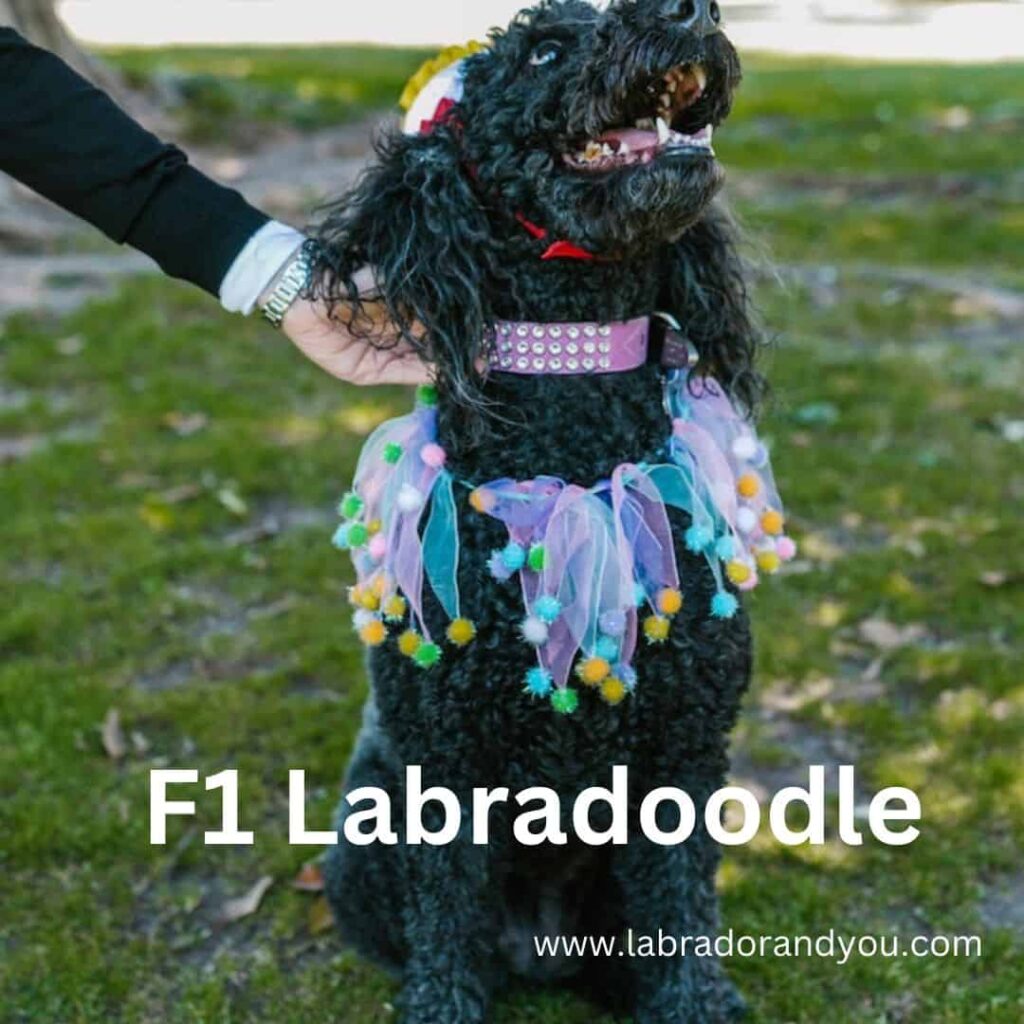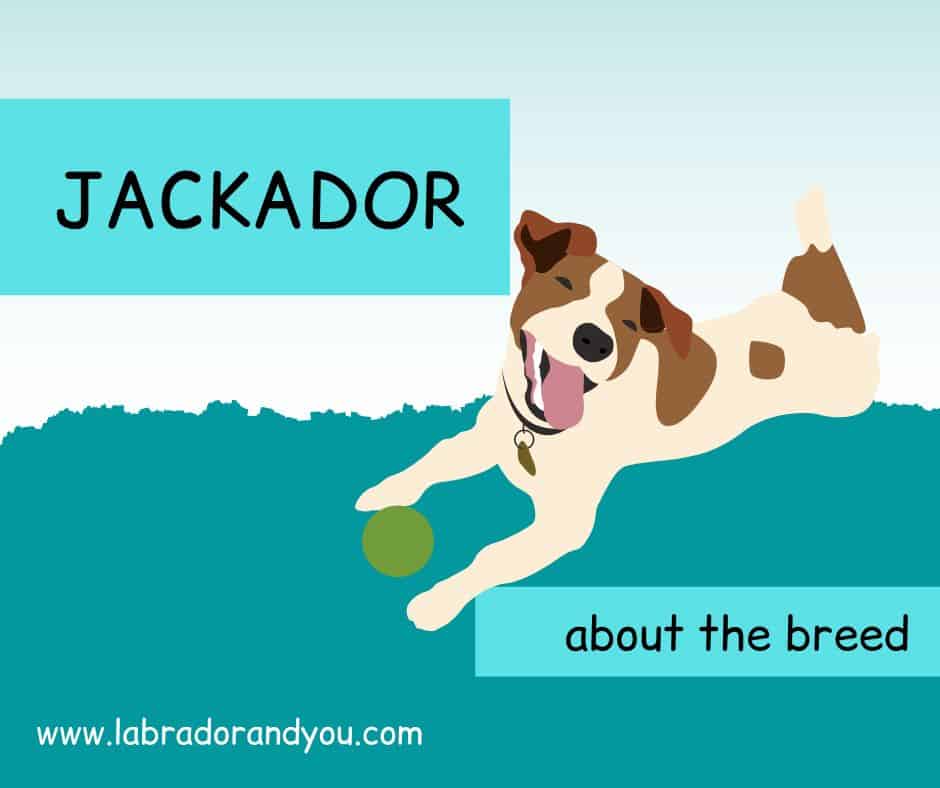Labradoodles are mixed-breed dogs initially originally bred to be hypoallergenic service dogs. They have become popular family pets as they tend to be less aggressive. They are a popular designer breed that combines the intelligence and loyalty of a purebred Labrador Retriever with the low-shedding coat of Poodles. This Labradoodle personality traits guide will recover all traits of the Labradoodle and more.
How Is The Labradoodle Personality Different From Labrador Retrievers?
Labradoodles share many personality traits with their Labrador Retriever ancestry, but subtle differences exist. While both breeds are friendly and outgoing, Labradoodles tend to be more sensitive and affectionate. This is due to the influence of Poodle ancestry.
Another difference is that Labradoodles are hypoallergenic. A Labrador Retriever is not. They shed less dander and hair, making them a perfect choice for people with allergies. These hypoallergenic guide dogs also make excellent pets for families looking for low-shedding breeds.
Labradoodles require minimal regular exercise to burn off energy while maintaining good health. You must feed them good quality food and monitor them for potential allergies. One significant difference between Labradoodles and Labrador Retrievers is their personality. While both breeds are friendly, Labradoodles tend to be more sociable and affectionate, making them the ideal family dog. Its origins trace back to the Royal Guide Dogs Association by vet Wally Conron.

Good Things About A Labradoodle’s Personality
Labradoodles have a lot of great personality traits that make them excellent pets. They make perfect sociable dogs. A labradoodle puppy is loyal to their owners. They are intelligent and eager to please. Easily trainable, they enjoy learning new skills and tricks.
They’re playful and perfect for families wanting outdoor activities or dog sports. Another remarkable aspect is their gentle nature around children – whether playing fetch in the backyard or snuggling up for a nap.
Challenges Labradoodle Owners Face As Labradoodle Puppy Grows
Labradoodle puppies are highly energetic, which can lead to destructive behavior without stimulation. New owners should also be prepared for the long house-training process for a Labradoodle dog. Be ready for a lot of patience.
Another challenge is their tendency to become over-excited around other dog breed or people. Not training early can lead to jumping up or pulling on leashes. Socialize them regularly so they learn how to behave correctly. Labradoodles do not do well when left alone for long periods. Separation anxiety may result in excessive barking.

Training My Labradoodle
Labradoodles are intelligent dogs, just like a labrador retriever As a guard dog breed, a Labradoodle should be trained to bark on command and stop when asked.
- Reward-based training is essential for ensuring their obedience and teaching them good behavior.
- Socializing with other dogs from a young age will instill good habits in them, reducing the likelihood of excessive barking.
- Family dogs benefit greatly from basic obedience training, including commands like ‘sit,’ ‘stay,’ and ‘come.’
- Establishing yourself as the alpha early on is essential by setting boundaries and rewarding positive behavior.
Labradoodles respond well to positive reinforcement techniques during training. If done right, it will build trust between first time dog owner and pet.
Guard Dog
Labradoodles make excellent watchdogs due to their protective nature. However, they are not explicitly bred as guard dogs. They often bark when someone approaches the property, making them an excellent deterrent for intruders.
Labradoodles can be trained to protect their owners as well. You can help your Labradoodle grow into a well-behaved watchdog with proper training and conditioning. A Labradoodle is ideal if you want a loving companion who can double as a watchdog without being overly aggressive.

Watch Dog
Labradoodles make excellent watchdogs due to their alertness and natural instinct. They are quick to bark when they sense suspicious activity. To train your, start with basic obedience training. Help them differentiate between friendly visitors and potential threats.
Family Dog
Labradoodles also make excellent therapy dogs due to their gentle temperament. They are patient and eager to bond with children, making them a perfect addition to any household. Their intelligence makes them easily trainable. Labradoodles can be integral to any loving family unit for years.
Service Dog
Labradoodles make great service dogs and therapy dogs because of their intelligence and temperament. As a therapy dog, they can help people with physical disabilities or mental health conditions like PTSD. They can perform tasks like fetching items, providing support while standing up or sitting down, and even alerting their owners during medical emergencies.
Due to minimal shedding and dander, their Poodle lineage makes them well-suited for hypoallergenic therapy dog work. They’re great at providing emotional support. Developing the desired behavior traits takes six months to two years of consistent training sessions.
Do Labradoodles Require A Lot Of Exercises?
Labradoodles are a high-energy breed. They need at least 60 minutes of physical activity daily, including walks or playtime. Be mindful of their growing joints during exercise. The standard labradoodle size affects their exercise needs compared to labrador retrievers.
Standard Labradoodles are larger and more active than mini Labradoodles. Hence, requiring more physical activity. Hip dysplasia is an issue for both breeds, which causes mobility problems. Failure to exercise may lead to destructive behavior. Regular walks alleviate excess energy.
Labradoodle & Labrador Retriever Health Conditions
Both are susceptible to specific health conditions impacting their quality of life. Heart disease is common as well. Regular visits to the veterinarian are needed. To minimize the risk, always find a reputable breeder who prioritizes the health of these designer dogs. Avoid puppy mills

Otitis +
Due to their floppy ears, Labradoodles are more likely to develop otitis externa, a common ear infection. This condition is due to inflammation or irritation of the external ear canal, leading to itching and discomfort.
Canine otitis externa can lead to hearing loss, which can be conductive, sensorineural, or mixed. If left untreated, it may cause complications, such as facial nerve paralysis or even meningitis. Schedule regular check-ups with your veterinarian and follow recommended ear cleaning guidelines at home.
Inner ear infection (otitis interna) in healthy dogs is often caused by a bacterial or fungal infection. This is less common than otitis externa but can cause sudden onset vestibular signs such as head tilt and loss of balance.
Lumps & Bumps +
They may develop lumps and bumps on their skin. These can be benign or malignant, so monitoring them closely is essential. Older and overweight dogs are more prone to developing lipomas, fatty lumps that don’t pose a significant risk.
Mast cell tumors are another type of skin mass that can affect Labradoodles, just like other dog breeds. Early detection is crucial, as this type of cancer can spread quickly if left untreated.
Watch for changes in your dog’s skin texture or the sudden appearance of new lumps or bumps. Regular grooming and vet check-ups are classic 101s.
Skin Allergies +
They are prone to skin allergies caused by dust mites, pollens, molds, or contact with specific shampoos or cleaning products. Symptoms of skin allergies may include:
- Excessive itching.
- Scratching.
- Biting at the area affected.
- Changes in their coat’s appearance due to licking or chewing.
Consult a veterinarian if you notice any of these symptoms so they can identify the allergen triggering the reaction.
- Bathing them regularly with hypoallergenic shampoos and gentle brushing helps reduce allergy symptoms.
- Switching to a high-quality diet free from common allergens like beef, wheat, or soy could also alleviate an allergic reaction.
Gastrointestinal Disorders +
Gastrointestinal (GI) disorders are common among Labradoodles with symptoms such as vomiting, diarrhea, and abdominal pain. Food allergies, infections, or stress can cause these issues. Monitor your dog’s eating habits and schedule regular check-ups to ensure their GI tract is healthy.
Severe GI conditions are gastric torsion or bloat. Bloat is life-threatening when the stomach fills with gas and twists on itself. This can cause reduced blood flow to vital organs like the heart and lungs, leading to shock or even death if left untreated.
Signs of bloat include restlessness, swollen abdomen, drooling excessively, pacing around anxiously, and retching without producing vomit.
Symptoms of gastrointestinal disorders should not be ignored as they could indicate more severe problems like inflammatory bowel disease (IBD).
IBD affects a dog’s digestive system by causing chronic inflammation in its intestinal lining leading to malnutrition and weight loss. Feeding them high-quality rich food; frequent exercise would help maintain their gut health.

Cruciate Ligament Disease +
Labradoodles are prone to cruciate ligament disease, a common condition that causes pain and lameness in their legs. True, especially for larger breeds of Labradoodles.
Frayed or ruptured cruciate ligaments cause instability in the knee, leading to discomfort and injury. Genetics plays a significant role. However, physical injuries can also trigger. Always keep them at a healthy weight and provide regular exercise.
Must Know Facts Before Buying Or Rehome A Labradoodle?
Firstly, be aware of the potential health issues associated with the breed. Ensure you purchase your Labradoodle from a reputable breeder who conducts thorough health screenings.
Secondly, crucial to consider their exercise requirements before taking them home. These high-energy intelligent dogs need plenty of daily exercises and mental stimulation to stay happy and healthy.
Lastly, training is vital when purchasing or rehoming a Labradoodle. They make excellent candidates for obedience training or other dog sports. Be patient.
Feeding Recommendations For Labradoodle Puppies
Finding a complete and balanced puppy food that meets their nutritional needs is vital.
- Good puppy food should contain animal protein, carbohydrates, fats, vitamins, and minerals.
- Labradoodles have big appetites and may eat things if not monitored.
- Dividing their daily rations into several meals is recommended instead of one large meal. This prevents overeating and reduces digestive problems.
- Never give your Labradoodle any human foods, which can cause obesity or gastrointestinal disorders.
- Proper feeding will help build healthy bones, muscles, and organs.

Are Labradoodles good with cats?
It depends on the dog’s personality and upbringing. Proper socialization and training from a young age can help.
Since they have a mixed breeding of Labrador Retrievers and Poodles, both considered cat-friendly breeds, Labradoodles typically get along well with felines.
Do Labradoodles shed a lot?
Labradoodles have less shedding than many other breeds due to their curly or fleece coat types. Frequent grooming and brushing will still be necessary.
Are Labradoodles calm?
One of the best things about Labradoodles’ personalities is how calm they can be. Their temperament makes them great family pets, as they are friendly toward children. Labradoodles love interacting with people.
Are Labradoodles Aggressive?
Labradoodles are not typically known for being aggressive dogs. They are gentle breeds. Labradoodles may display territorial aggression between the ages of 1 and 4 when they become more confident. This is prevalent in male Labradoodles but can also occur in females.
Socializing your dog from a young age is essential to minimize this aggression.In some cases, Labradoodles may develop protective aggression if they feel their pack or family is threatened. This behavior can happen with any dog breed and stems from a natural instinct.
Can Labradoodles Be Left Alone?
Labradoodles can be left alone for some hours; However, leaving a Labradoodle alone too often or for more than 3-4 hours can lead to separation anxiety and destructive behavior. They are social animals who crave human interaction. These dogs bond closely with their owners and thrive on companionship and affection.
Proper training methods such as crate training and positive reinforcement can help ease the transition. Always monitor how long you leave your dog and put proper care measures in place. Activities like puzzle games or chewing toys are great.
Can Labradoodles Swim?
Labradoodles are known for being water-loving dogs, and their heritage from two working dog breeds makes them excellent swimmers. Even miniature Labradoodles can learn to swim and enjoy it as much as standard-sized ones.
Swimming helps build muscle mass, improve cardiovascular health, and keep them fit. Moreover, since it’s low-impact, it puts less stress on joints than other high-intensity exercises like running or jumping.
When Do Labradoodles Calm Down?
Labradoodles start to settle into a more relaxed state around three years old.
Are Labradoodles Easy To Train?
Labradoodles are considered easy to train. Their purebred parents, the Labrador Retriever, and the standard Poodle, are highly intelligent and trainable breeds.
This intelligence is passed on to Labradoodles, making them quick learners who respond positively to positive reinforcement training methods. They have a strong work ethic, which makes them ideal for tasks like a guide dog or service dogs.
What Is The Best Way To Motivate A Labradoodle?
Labradoodles are highly social dogs. The best way to motivate them is through playtime. Engage them in interactive games like fetch or tug of war.
Positive reinforcement is also an effective technique. Offering treats or praise when they display good behavior encourages them to repeat that behavior in the future. This approach makes training less stressful.
Is A Labradoodle Suited To Apartment Living?
Labradoodles are well-suited for apartment living because of their adaptable personalities compared to other dogs. They are not particularly high-strung, so they will be comfortable in smaller spaces.
If I Get A Second Labradoodle, Will They Both Get Along?
When considering getting a second Labradoodle, there is no guarantee they will get along. Each dog has its unique personality and preferences for other dogs. Picking the right match for your current Labradoodle temperament and energy level can increase their chances of getting along.
Properly introduce the two dog breed before living together. This involves gradual introductions in neutral territories such as parks or a friend’s home. Introducing a very new Labradoodle puppy into your home should be done carefully and gradually, with some supervision at first.
Do Labradoodles Bark A Lot?
Labradoodles may be prone to excessive barking; it depends on the individual dog. They may bark at specific triggers, such as strangers or other animals.
Do Labradoodles Bond To One Person?
Labradoodles tend to have preferred individuals and bond strongly with one person. They love cuddles. This is why you may notice your Labradoodle following you around the house or seeking your attention more than anyone else.
Is A Male Or Female Labradoodle Better?
First time dog owners claim differences in the personalities of the two sexes. Male Labradoodles tend to be more loving and affectionate dogs.
On the other hand, female Labradoodles are reportedly more independent and run away less frequently than males. It’s worth noting that neuter status can cause variations in temperament among male and female dogs.
Research shows that early spay/neutering in puppies can affect their behavior as adults. While some believe males may be sweeter than females because they’re more clingy, it depends on each dog’s personality traits.
Do Labradoodles like to cuddle?
Yes very much so. They are very clingy to their owner and are very sociable and love getting cozy.
Author Profile

- Lifetime dog Enthusiast
- Shradha is a seasoned writer at Labradorandyou.com, an authoritative resource for all things Labrador Retriever. Her experience as a pet owner and dog enthusiast drives her to create meticulously researched and fact-checked content, offering valuable insights on Labrador training, grooming, and health. Each article reflects Shradha's passion and dedication, enriched by personal experiences with her beloved Labradors, Tom, and Kurt. Whether exploring breed-specific training techniques or providing product reviews, Shradha ensures Labrador owners receive the most accurate, up-to-date, and trustworthy information, aimed at enhancing their companions' health and happiness
Also by the author
-
 Lab-TypesJuly 8, 2025مقارنة بين تحميل تطبيق 1xbet للإصدارين أندرويد وiOS
Lab-TypesJuly 8, 2025مقارنة بين تحميل تطبيق 1xbet للإصدارين أندرويد وiOS
-
 casinoJuly 8, 2025Başarıbet Casino Chicken Güvenilir Casino & Bahis Oyunları
casinoJuly 8, 2025Başarıbet Casino Chicken Güvenilir Casino & Bahis Oyunları
-
 Lab-TypesJuly 8, 2025вас Сыграть На Mostbet Com? Доступ войти Здесь”
Lab-TypesJuly 8, 2025вас Сыграть На Mostbet Com? Доступ войти Здесь”
-
 Pin UP Online CasinoJuly 8, 2025Pul Çıxarılması ilə Ən Yaxşı Kazinolar: Download və Rəsmi Saytlar
Pin UP Online CasinoJuly 8, 2025Pul Çıxarılması ilə Ən Yaxşı Kazinolar: Download və Rəsmi Saytlar





